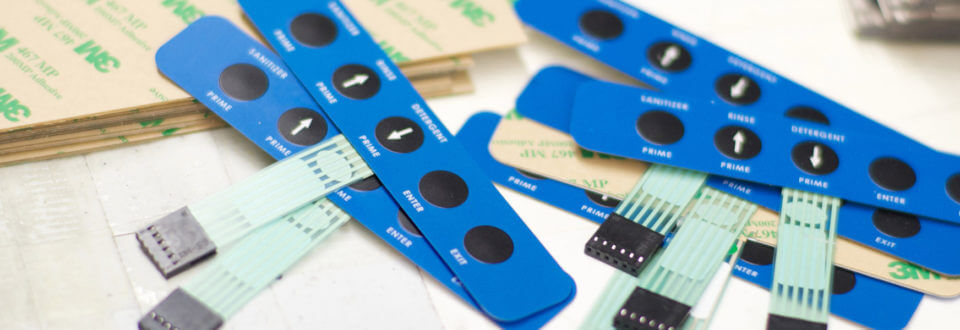The Role of Membrane Switch Technology in Improving Product Interfaces
The Role of Membrane Switch Technology in Improving Product Interfaces
Blog Article
The Benefits of Utilizing Membrane Layer Switches Over in Customer Electronics
Membrane switches are significantly identified for their substantial advantages in consumer electronic devices, especially in improving user interaction and simplifying manufacturing procedures. The convenience in style allows for tailored solutions that meet diverse customer needs.
Enhanced Individual Experience
In today's competitive landscape of consumer electronics, improved customer experience is paramount; almost 85% of individuals prioritize user-friendly interfaces. Membrane switches over play a crucial function in achieving this degree of use. Their flat, low-profile design enables seamless combination into different devices, reducing bulk while maintaining performance. This style aesthetic not only improves the aesthetic charm yet likewise adds to an extra structured customer interaction.
The responsive feedback offered by membrane switches is necessary for assisting individual actions, making sure that commands are registered accurately. This feedback system reduces errors and enhances individual complete satisfaction, promoting a favorable relationship in between the user and the tool. The customizable nature of membrane switches over enables suppliers to customize interfaces to details customer needs, making tools more available and inviting.
Furthermore, membrane switches can include backlighting and visuals overlays, further improving visibility and usability in diverse settings. This adaptability ensures that tools remain user-friendly and useful, no matter of the setup. On the whole, the assimilation of membrane switches right into customer electronics dramatically enhances customer experience, driving brand name loyalty and complete satisfaction in a significantly open market.
Economical Manufacturing
Customer electronic devices manufacturers are regularly looking for means to stabilize top quality with affordability, and membrane layer buttons offer a compelling service for cost-effective production. membrane switch. These components are naturally less complex than standard mechanical buttons, which minimizes both manufacturing expenses and intricacy. The light-weight layout of membrane switches over permits reduced shipping expenses and simpler combination right into portable gadgets, even more enhancing their allure in an open market

Manufacturers can create membrane switches in high volumes, making use of economies of range. This mass manufacturing capacity makes sure consistent quality while dramatically lowering per-unit expenses. Additionally, the products used in membrane layer switches, such as polyester and polycarbonate, are often cheaper than those needed for standard switch innovations, adding to general price financial savings.
The manufacturing procedure for membrane layer changes normally requires less actions and less labor contrasted to various other button types. This structured technique not just reduces labor prices yet likewise accelerates time-to-market, allowing firms to react promptly to customer need. As a result, the combination of decreased product expenses and reliable production processes positions membrane layer changes as a smart investment for manufacturers aiming to supply top notch customer electronics at affordable cost points.
Style Versatility and Customization
While traditional mechanical buttons often impose restrictions on layout due to their bulk and called for placing mechanisms, membrane switches supply unparalleled versatility and customization choices for consumer electronics. This cutting-edge innovation permits designers to create streamlined, inconspicuous user interfaces that can effortlessly integrate into numerous product visual appeals, from smartphones to kitchen area home appliances.
Membrane switches can be created in essentially any type of shape or dimension, making it possible for producers to tailor the layout to specific ergonomic and practical requirements. This versatility not only improves individual experience but also enables for imaginative styles that straighten with brand identity. The use of printed graphics on membrane changes provides the opportunity for intricate layouts and lively colors, which can be conveniently customized without significant price implications.
Additionally, membrane buttons can include multiple capabilities right into a solitary layer, reducing the need for several components and streamlining assembly processes. This streamlined design approach minimizes area and weight, making it ideal for compact consumer electronics. Overall, the design adaptability and customization abilities of membrane layer switches encourage manufacturers to innovate, inevitably leading to even more user-friendly and appealing items.
Resilience and Dependability
As modern technology remains to advance, the durability and reliability Source of membrane layer switches have come to be vital considerations for manufacturers in the consumer electronic devices industry. Membrane layer switches are designed to withstand rough environmental problems, consisting of temperature fluctuations, moisture, and dirt exposure. Their durable building usually involves multi-layered materials that give a reliable obstacle against impurities, guaranteeing long life and regular efficiency.
In addition to environmental resistance, membrane layer changes deal remarkable mechanical my explanation integrity. Unlike typical mechanical switches, which might break gradually, membrane layer changes utilize a closed design that minimizes the threat of mechanical failure. The absence of moving parts not only enhances their life expectancy but also reduces damage, making them suitable for high-usage applications.
Furthermore, membrane buttons can endure a significant variety of actuations without loss of functionality, usually exceeding millions of cycles (membrane switch). This resilience equates to lower replacement prices and decreased downtime for customers and suppliers alike. In general, the mix of ecological resilience and mechanical reliability makes membrane layer switches over a strategic choice for customer electronics, making sure that devices remain effective and operational throughout their intended lifespan

Streamlined Item Growth
The toughness and reliability of membrane layer switches substantially add to structured product advancement in the customer electronic devices sector. By integrating these switches early in the layout procedure, suppliers can minimize the complexity and variety of parts required in their items. Membrane layer buttons are lightweight and compact, enabling more efficient space use within tools, which can cause streamlined assembly processes.

The simplicity of manufacturing membrane switches also plays an important function in item development. With modern-day printing strategies and materials, production can be scaled efficiently, lowering and minimizing lead times waste. This causes lower production prices, enhancing overall success.

Final Thought
In final thought, membrane switches significantly improve consumer electronics by giving a boosted user experience, cost-effective production procedures, and flexible design choices. Their sturdiness and integrity ensure regular efficiency in various environments, while streamlined item development facilitates quicker time-to-market. These advantages collectively contribute to the advancement and capability of consumer gadgets, dealing with the progressing needs of individuals successfully. The combination of membrane changes stands for a calculated selection for manufacturers seeking to optimize product design and efficiency.
Membrane switches are increasingly recognized for their significant benefits in consumer electronics, particularly in improving user communication and simplifying production processes. Furthermore, the products utilized in membrane buttons, such Homepage as polyester and polycarbonate, are typically much less pricey than those required for conventional switch modern technologies, adding to overall price savings.
The production procedure for membrane layer changes typically needs fewer actions and less labor contrasted to other switch types. Unlike typical mechanical switches, which might use out over time, membrane changes make use of a closed style that reduces the risk of mechanical failure.In verdict, membrane changes significantly boost consumer electronic devices by supplying a boosted user experience, economical production procedures, and flexible design options.
Report this page